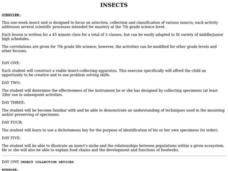Curated OER
Classroom Meteorologists: An Experiential Approach to Learning about Seasons and Weather
Students examine several concepts about weather in the seven lessons of this unit. This year long activity helps students to gather data seasonally about wind, clouds, precipitation, and temperature. Earth's three climate zones are...
Curated OER
Emotion Masks
Students analyze and discuss masks of different cultures as an art form to evoke emotion. This lesson culminates in the creation of individual mask designs and self-directed assessment (included).
Curated OER
Traveling Through the Solar System
Students use calculator and non-calculator methods for analyzing data. They apply data collection and analysis in a study of mass and weight. Students enhance and apply the concept of line of best fit. They master graphing in a plane,...
Curated OER
Folk Genres
Students classify folk life traditions into folk genres. They create folk genre museums by laying down their images or postcards wherever they see a relationship. They give each an image to examine in depth and decide which folk genre...
Curated OER
Counting Crows
Students discuss the fable, The Crow and the Pitcher. In this literature lesson, students read the fable and create a crow sock puppet. Students use their puppets to dramatize the fable.
Curated OER
Mental Money
Students access prior knowledge to round numbers and add decimals. In this mental math lesson, students share the book Betcha and calculate estimates for three jars based on the book. Students calculate money answers based on coins...
Curated OER
Marketing Research Projects
Students research customer service offerings of a particular business and present their conclusions to the class using PowerPoint and additional visual aids. The guidelines for this lesson can be found through the National DECA.
Curated OER
Nouns and Verbs and Proper Nouns, Oh My!
Second graders identify nouns and verbs in written communication. They distinguish between between nouns, proper nouns, and verbs. Students discuss the difference between these parts of speech. In partners, 2nd graders write a sentences...
Curated OER
Acid Neutralization Lab
Students discuss and design a lab to measure pH of limestone, pyrite, limestone-pyrite mixtures and their control. They have their labs approved by the instructor before they begin. Students preform the lab and explore the acid-base...
Curated OER
Designing And Filming Commercials
Students design and film commercials using digital video cameras and the computer program iMovie in this exciting lesson plan provided by the Florida Center for Instructional Technology.
Curated OER
Insects
Students construct a viable insect collecting apparatus. Students determine the effectiveness of the instrument he has designed by collecting specimens.
Curated OER
Amate Bark Paintings/Folk Arts of Latin America
Students explore the history of bark paintings in South America and produce their own version of these paintings.
Curated OER
The Terminology of Governance
Learners explore the parts of Canada's federal system of government. They construct a concept web using the terms related to government and the institutions of Canada. They make lists that relate to Canadian and American government.
Curated OER
The Earth in Space
Students use computer images to explain why the Earth has seasons and examine the phases of the moon. They create 3-D images and present them to the class. They answer a series of questions at the end of the lesson.
Curated OER
Bioethics: Tool for Portfolio and Performance Assessment
Students, in cooperative studying groups, assume the affirmative or negative position of a particular issue (premise). They research the issue and participate in a debate. In addition, they write essays to complete a portfolio entry.
Curated OER
Lewis and Clark: Prized Possession
Students create a Sacagawea-inspired wampum belt. In this Native-American lesson plan, students study Sacagawea and her influence on the Lewis and Clark expedition. Students learn about wampum and prized possessions and work in groups to...
Curated OER
Principles of Flight: Where are We?
Young scholars explore the concept of topographical maps. In this topographical map lesson, students discuss how airplanes know where to fly. Young scholars use topographical maps to simulate a field trip on the computer.
Curated OER
Comparing/Ordering Numbers
Third graders compare numbers. In this math lesson students compare ones, tens, and hundreds. They also order numbers from least to greatest and from greatest to least.
Curated OER
Giving Voice to History
Students examine the plight of Japanese Americans during World War II. In this World War II lesson, students participate in a mock evocation simulation, research primary and secondary documents about internment camps, and share their...
Curated OER
The Monkey Dance: Exploring Balinese Culture
Students explore Balinese culture. In this Balinese integrated fine arts instructional activity, students listen to a podcast of "The Monkey Dance," taking notes about important features of the dance. Students participate in a jigsaw...
Curated OER
Concept Structures in Architecture
Students develop a creative building design. In this technology lesson, students create a model of their building using a computer software. They present their final product in class.
Curated OER
Patterns Here, There, and Everywhere!
Upper graders access the Microsoft Word program and create patterns by utilizing certain keys on the keyboard. They create picket fences, smiley faces, and hearts. It seems that this lesson has as much to do with keyboarding skills as it...
Discovery Education
Sonar & Echolocation
A well-designed, comprehensive, and attractive slide show supports direct instruction on how sonar and echolocation work. Contained within the slides are links to interactive websites and instructions for using apps on a mobile device to...
Curated OER
Toothpick Triangles
Explore patterns, variables, and mathematical relationships when you examine patterns with toothpicks and determine the next sequence of figures. Your class writes and justifies a formula based on the sequence. An answer key is included.

























